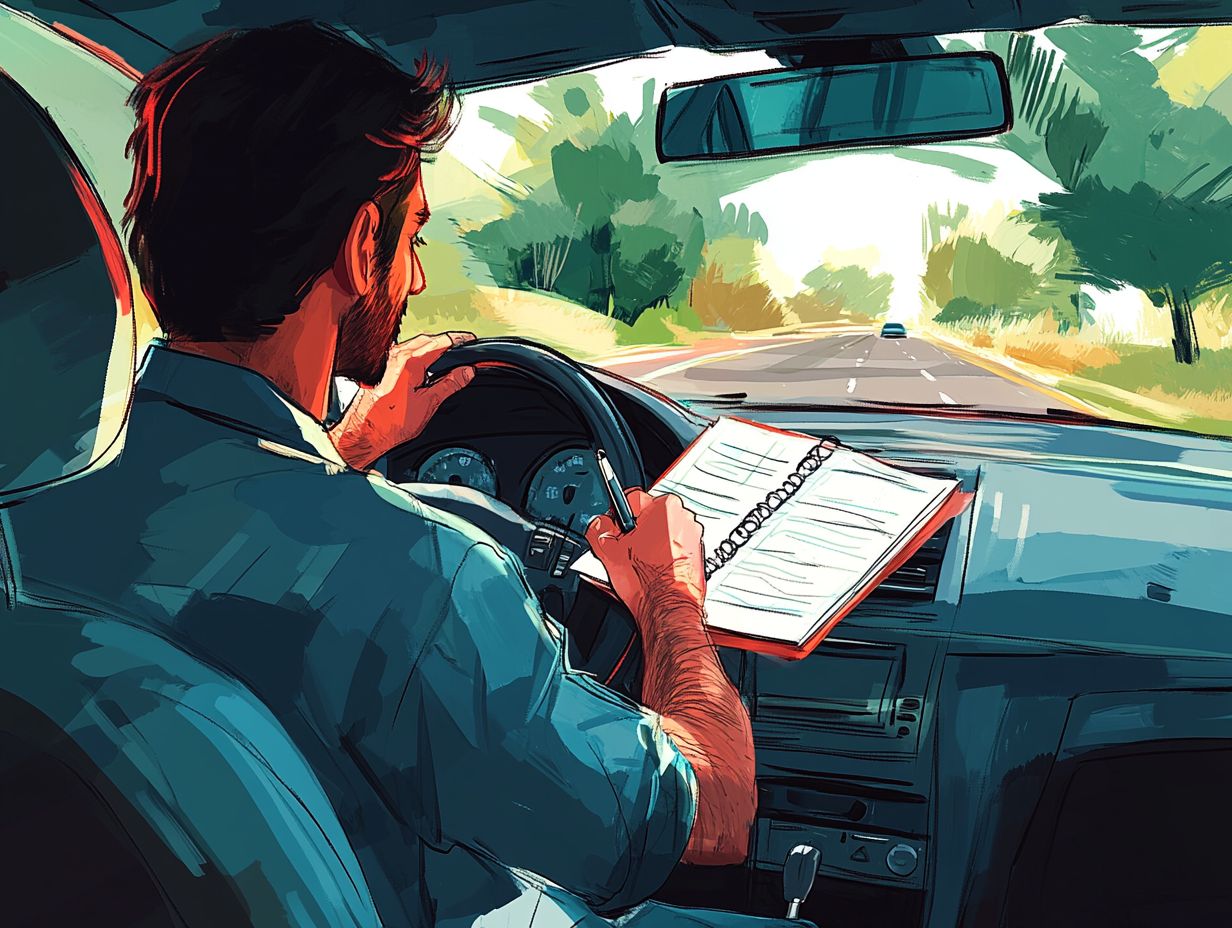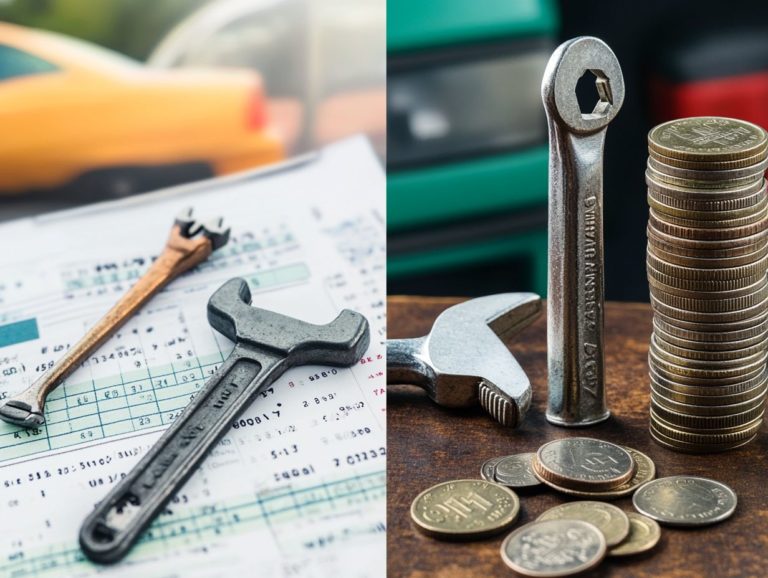What to Look for When Test Driving a Car
Buying a car? The test drive is an important step in your decision-making journey.
This is your chance to experience the vehicle’s performance firsthand. Evaluate its features and see if it meets your needs.
This guide will empower you to confidently navigate the test drive experience! You’ll be fully equipped to make an informed decision before finalizing your purchase.
Contents
- Key Takeaways:
- Preparing for the Test Drive
- During the Test Drive
- Questions to Ask During the Test Drive
- After the Test Drive
- Frequently Asked Questions
- What key things should I focus on during my test drive?
- How can I ensure I get the most out of my test drive?
- What should I pay attention to during the test drive?
- Are there any red flags I should watch out for during the test drive?
- Should I bring someone with me on the test drive?
- What should I do after the test drive?
Key Takeaways:

- Research beforehand to understand the car’s features and capabilities. This helps you make a more informed decision.
- During the test drive, pay attention to both the exterior and interior, as well as its performance. This gives you a well-rounded understanding of the car’s condition.
- Ask questions about maintenance, warranty, and the car’s history during the test drive. This can help you avoid surprises after the purchase.
Preparing for the Test Drive
Preparing for a test drive is crucial when you’re considering a new car. You’ll get to experience the vehicle’s driving comfort, performance, and safety features in a way that specs alone cannot convey.
Before heading to the dealership, spend time researching models and specific features. Look at aspects like interior space and comfort adjustments that align with your lifestyle.
Also, take time to learn about the available safety features. These can greatly enhance your driving experience and offer peace of mind on the road.
Researching the Car and Its Features
Researching a new car thoroughly before your test drive is important. It ensures the car fits your family’s needs and safety requirements.
Start by using online resources that simplify car comparisons. Explore reliable automotive websites for specifications, performance metrics, and pricing.
Reading reviews on safety features will provide insights into real-world crash test results and user experiences. Consider how child seats fit and overall comfort during travels.
Setting Up a Test Drive Appointment
Setting up a test drive appointment at your local dealership is a key step in your car-buying journey. It allows you to evaluate the vehicle’s performance firsthand.
Choose the right dealership to enhance this experience. Look for those with excellent customer reviews and a variety of vehicles that match your preferences.
When contacting the dealership, ask about the test drive durations available. Some offer extended options for a thorough assessment.
Preparation is essential. Think about the features that matter most to you and confirm that your desired vehicle is in stock. Knowing the price range of the cars you like will empower you to negotiate effectively.
During the Test Drive
As you begin the test drive, focus on evaluating the vehicle’s performance. This experience offers insights into its driving dynamics, handling, and key safety features that are vital for your family’s well-being.
Checking the Exterior and Interior

When you check the exterior and interior of the vehicle during your test drive, focus on important details. Look for oil leaks, notice if the tires are balding, and ensure the doors open and close smoothly. This thorough inspection is key.
Take a good look at the safety features. They are crucial for your experience, especially when traveling with young passengers. Examine the airbags, child safety locks, and stability control systems to ensure they re in top condition.
Comfort should also be high on your checklist. Assess the seating materials and the space available, particularly for accommodating child seats. This could influence your decision.
Don t overlook the interior layout and features. Things like climate control and entertainment options can significantly enhance the driving experience for families.
Inspecting these elements will give you peace of mind. You want to ensure that you re making a wise investment.
Assessing Performance and Handling
Evaluating the performance and handling of a vehicle during your test drive is essential. Key aspects to consider include how the steering feels, braking feel, and the effectiveness of the emergency brake.
Consider how the vehicle reacts in various driving conditions, whether it s wet roads or sharp turns. Evaluating acceleration helps you gauge the vehicle’s stability when merging onto highways or overtaking slower traffic.
Pay attention to how well the vehicle handles bumps on the road. This can enhance your overall driving comfort and safety.
By thoroughly examining these elements, you can make informed decisions that align with your driving needs and expectations.
Questions to Ask During the Test Drive
The right questions can uncover hidden gems about the car s history, maintenance needs, and warranty coverage. This information enriches your overall buying experience.
Understanding Maintenance Costs and Warranty Protection
Inquiring about maintenance and warranty options during your test drive is crucial. It can significantly influence the long-term costs and reliability of your future vehicle.
As a potential buyer, consider both the vehicle’s history and its built-in safety features. These elements are pivotal for determining suitable driving insurance options.
By staying informed about these aspects, you can make smarter choices for a safer and more economical driving journey.
Understanding the Car’s History and Condition
Knowing a car’s history and current condition is essential when you re contemplating a purchase. This knowledge can save you from future headaches!
Diving into these details can uncover critical information that may sway your decision. For example, asking about previous ownership reveals how well the car has been maintained.
Understanding the accident history is equally crucial, as it may uncover hidden structural problems. Details from the last inspection can shed light on the vehicle’s current state and highlight any impending repairs.
Engaging in these discussions with the dealership clarifies your understanding. It empowers you to make informed choices that protect your investment in the long run.
After the Test Drive

After your test drive, it’s essential to evaluate your experience thoughtfully. This reflection will help you determine whether to proceed with the purchase or explore other options.
Evaluating the Experience and Making a Decision
Evaluating your test drive experience against your family’s needs and the comfort offered by the vehicle is a crucial step in your decision-making process.
During this important evaluation, consider how well the vehicle fits each family member, from the little ones to the adults, particularly in terms of spaciousness and seating comfort. Reflect on the safety features that stood out to you. Were there advanced systems, like lane departure warnings (which help keep you safe on the road) or adaptive cruise control (which maintains a safe distance from other vehicles), that piqued your interest?
Think about how the vehicle performed on various terrains. Did it provide a smooth ride on highways as well as on those bumpy back roads? Assessing these elements will help you determine whether the car truly aligns with your family s lifestyle and needs.
Negotiating and Finalizing the Purchase
Negotiating the final price and terms of your car purchase is a crucial step in the process; it ensures you secure the best value for your investment.
Do your homework to snag the best deal! By researching the market and familiarizing yourself with the typical price range for your desired model, you empower yourself to engage in meaningful discussions.
Stay ready to walk away if the terms fall short of your expectations; this mindset often prompts sellers to rethink their offers. Once you reach an agreement, review all the terms, including financing options, warranties, and any additional fees. This ensures you have a complete understanding and helps you avoid any hidden costs that may arise.
This thorough approach will lead to a more rewarding and financially sound transaction.
Frequently Asked Questions
What key things should I focus on during my test drive?
When test driving a car, you should pay attention to the overall driving experience, the car’s performance, safety features, and refer to what to look for in a used car test drive for any potential issues or red flags.
How can I ensure I get the most out of my test drive?

To get the most out of your test drive, make sure to test the car in different driving conditions, such as on the highway and in stop-and-go traffic. It’s also important to take your time and thoroughly inspect the car’s features and functions.
What should I pay attention to during the test drive?
During the test drive, pay close attention to the car’s handling, acceleration, and braking, as well as any unusual noises or vibrations. Additionally, consider what to look for in an electric vehicle test drive by testing out all of the car’s features, such as the air conditioning, radio, and navigation system.
Are there any red flags I should watch out for during the test drive?
Yes, some red flags include a rough ride, difficulty changing gears, or any warning lights on the dashboard. These could be signs of potential mechanical issues.
Should I bring someone with me on the test drive?
Bringing someone with you can provide an extra set of eyes and ears to help spot any potential issues. It’s also helpful to have someone else’s opinion and feedback on the car’s overall performance.
What should I do after the test drive?
After the test drive, reflect on your experience and jot down any thoughts. If you have any concerns or questions, don’t hesitate to ask the salesperson for more information before making a final decision.






